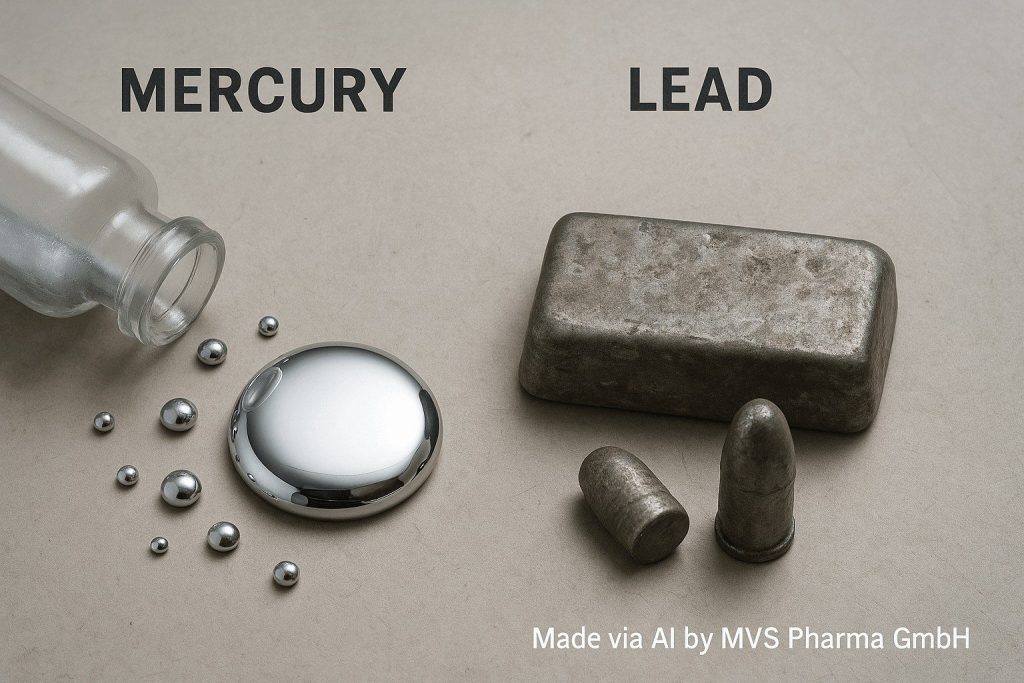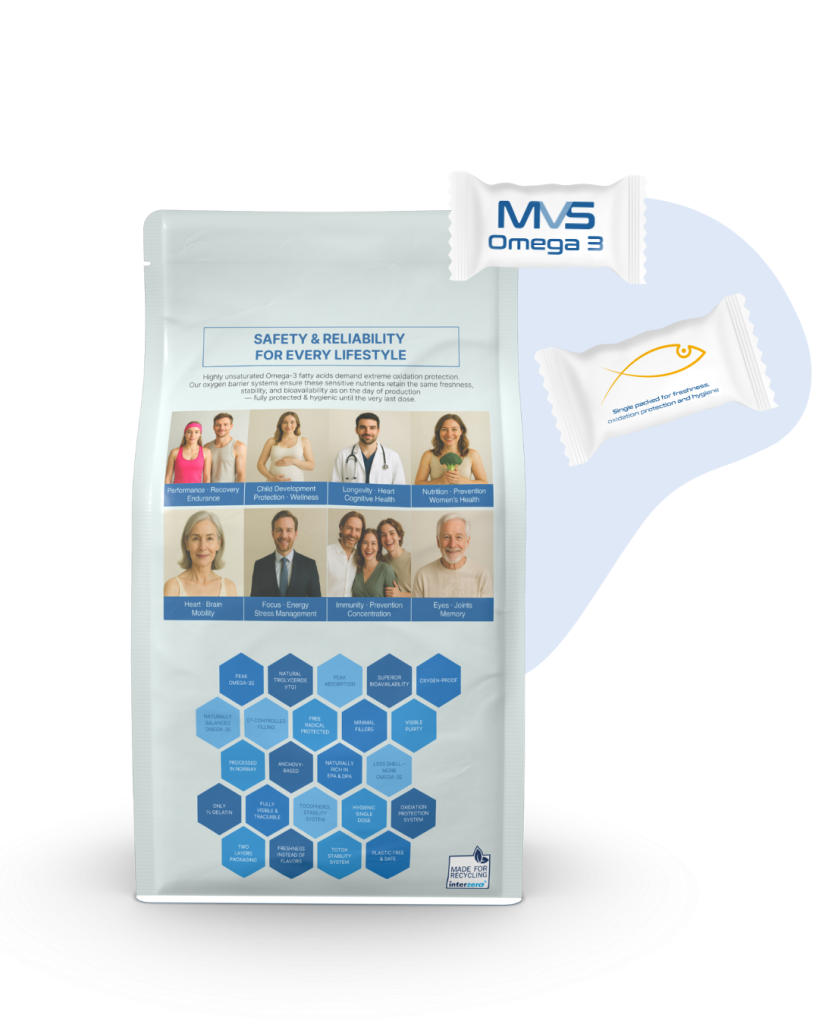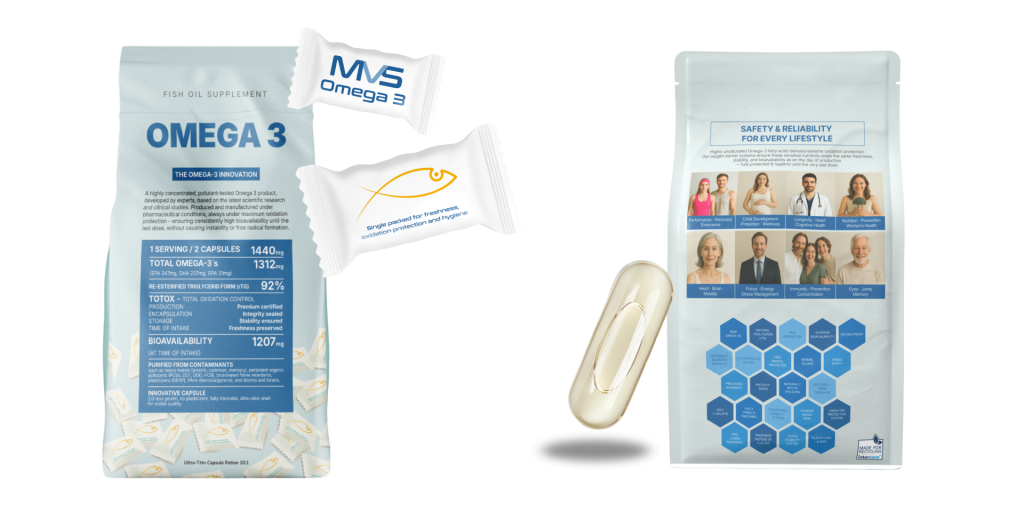Table of Contents
The Overlooked Factor in Supplement Quality
When people shop for Omega-3 supplements, they usually compare dose, form (fish vs algae), or price. But packaging — how the oil is processed, stored, and sealed — is often overlooked. In reality, packaging is the frontline defense against oxidation, contamination, and loss of potency.
With EPA and DHA being among the most fragile nutrients, packaging makes the difference between a supplement that delivers health benefits and one that delivers rancid oil. This article explores the latest science and technology of Omega-3 packaging in 2025, and how it ensures safety, stability, and efficacy.
Why Packaging Matters for Omega-3s
- EPA and DHA are highly unstable: multiple double bonds make them prone to oxidation.
- Exposure to oxygen, light, and heat during storage and distribution can rapidly degrade quality.
- Packaging choices directly affect:
- Freshness (TOTOX values)
- Bioavailability
- Shelf life
- Safety from contaminants
In short, packaging is not cosmetic — it’s a functional health safeguard.
Raw Materials & Pollutants in Omega-3 supplements
The primary raw materials for these supplements include fish oil, algal oil, and krill oil. Fish oil is commonly obtained from fatty fish like salmon, while algal oil is sourced from algae, making it a suitable option for vegetarians and vegans. Krill oil, derived from small crustaceans known as krill, is another source rich in omega-3s.

However, the purity of these raw materials is a critical consideration. Contaminants such as heavy metals (e.g., mercury, lead), PCBs (polychlorinated biphenyls), dioxins, and other pollutants can potentially be present in the marine environments from which these raw materials are sourced. These contaminants may find their way into the omega-3 supplements during the extraction and processing stages.
The bottom line is that even if many of these companies do follow legally regulated amounts for the contents of harmful and heavy metals, they still exist in the capsule. Yes, they may be generally considered safe, but the law is different in each country, and so are the variables for how much of these harmful substances your omega-3 supplement should and can contain. So, at the end of the day, you are taking in harmful substances with each capsule, and in some cases (if the brand is not reliable), the benefits are vastly outweighed by the detriments.
Common Sources of Contamination in Omega-3 Supplements
Even before packaging, raw materials can carry pollutants from the marine environment:
- Heavy metals: mercury, lead, cadmium, arsenic.
- Persistent organic pollutants: PCBs, dioxins, hexachlorobenzene.
- Agricultural chemicals: DDT, DDE, DDD.
- Microplastics.
Proper molecular distillation and purification can remove these, but packaging must prevent recontamination or oxidative instability.
The Link Between Packaging and Bioavailability
Freshness isn’t just about taste. Oxidation reduces absorption of EPA/DHA and may generate compounds that interfere with metabolism. Clinical research shows:
- Fresh rTG-form Omega-3s in protective packaging reach significantly higher Omega-3 Index levels than oxidized oils in bulk bottles.
- Packaging, form (rTG > EE), and co-ingestion with fat all work together to maximize bioavailability.
Capsule and Packaging Options in 2025
- 1. Softgel Capsules
- Most common format.
- Pros: cheap, easy to swallow.
- Cons: permeable to oxygen over time, bulk packaging allows oxidation with every opening, and is prone to a rancid smell.
- 2. Liquid-Filled Capsules (Sealed Individually)
- More resistant to oxygen compared to bulk softgels.
- When sealed individually in blister strips, protection is significantly improved.
- 3. Vegetarian Capsules
- Made from plant-based materials (HPMC, pullulan).
- Important for vegan/vegetarian consumers (algal oil).
- Require oxygen-barrier technology to ensure stability.
- 4. Krill Oil Phospholipid Capsules
- Naturally more stable due to phospholipid structure.
- EPA/DHA levels are lower, so protective packaging is still essential.
Filler Ingredients
When manufacturing fish oil products, there is always some percentage of filling material inside the capsules. Omega-3 capsules, like many other dietary supplements, often contain additional ingredients known as excipients or fillers. These ingredients serve various purposes, such as improving stability, enhancing absorption, or providing a suitable form for the supplement. Common fillers and excipients found in omega-3 capsules may include:
- Glycerin: Glycerin is used to maintain the moisture content in the capsules and prevent them from drying out.
- Purified Water: Water may be added to the formulation for various purposes, including maintaining the proper consistency of the ingredients.
- Antioxidants: To prevent the oxidation of omega-3 fatty acids, which can lead to rancidity, antioxidants such as vitamin E (tocopherols) may be added.
- Lemon Oil or Natural Flavors: Some manufacturers add natural flavors, typically from lemon oil, to mask the fishy taste or aftertaste that can be associated with omega-3 supplements.
- Mixed Tocopherols: These are a group of compounds with vitamin E activity, and they are frequently added as antioxidants to protect the omega-3 fatty acids from oxidation.
- Rosemary Extract: Another natural antioxidant, rosemary extract, may be used to help maintain the freshness and stability of the omega-3 oils.
- Soy Lecithin: Soy lecithin is sometimes included to improve the dispersion of the omega-3 fatty acids, potentially aiding in absorption.
Why do some Omega-3 supplements contain Vitamin A and E?
Some omega-3 supplements contain added vitamin A and E for several reasons, reflecting a comprehensive approach to nutritional supplementation:
- Antioxidant Protection
Vitamin E, a potent antioxidant, is often included to protect the omega-3 fatty acids (EPA and DHA) from oxidation. The unsaturated nature of these fatty acids makes them susceptible to oxidative damage, leading to rancidity. Vitamin E helps counteract this process, maintaining the freshness and effectiveness of the supplement.
- Synergistic Health Benefits
Vitamin A, known for its role in vision, immune function, and skin health, may be added to omega-3 supplements to provide a synergistic effect. The combination of omega-3 fatty acids with vitamin A can contribute to overall eye health and immune system support.
- Stability and Shelf Life
Including antioxidants like vitamins A and E helps enhance the stability and prolong the shelf life of the omega-3 supplement. This is particularly important as it ensures that consumers receive the intended health benefits without the risk of consuming rancid or degraded fatty acids.
- Comprehensive Nutritional Support
Some formulations aim to provide a more comprehensive range of nutrients. By combining omega-3 fatty acids with vitamins A and E, the supplement may offer a broader spectrum of health-promoting effects, potentially supporting various aspects of well-being.
- Reducing Oxidative Stress
Omega-3 fatty acids themselves exhibit anti-inflammatory properties, and combining them with antioxidants like vitamins A and E may help reduce oxidative stress in the body. This combination is thought to provide a more holistic approach to supporting cardiovascular and overall health.
Capsule variants
Omega-3 supplements come in various capsule variants, each with its own characteristics. Here are some common capsule variants used for packaging omega-3:
- Soft Gel Capsules (Soft gels): Soft gel capsules are a popular choice for omega-3 supplements. They are typically made of gelatin or other polymers and contain a liquid or gel-like form of omega-3 fatty acids.
- Considerations: May not be suitable for those with gelatin allergies, and the gelatin itself may be of animal origin.
- Enteric-Coated Capsules: Enteric-coated capsules have a special coating that prevents them from dissolving in the stomach. Instead, they release their contents in the small intestine.
- Advantages: Minimizes the risk of fishy aftertaste or burps as the release occurs in the intestine, protecting against stomach acids.
- Considerations: Typically more expensive, and the coating may contain additional ingredients.
- Vegetarian/Vegan Capsules: Capsules made from plant-derived materials, such as cellulose or tapioca, are suitable for vegetarian and vegan consumers.
- Advantages: Plant-based alternative to gelatin capsules, addressing dietary preferences and restrictions.
- Considerations: May have different dissolution characteristics compared to gelatin capsules.
- Liquid-Filled Capsules: Similar to soft gel capsules, but with a liquid fill. These may be transparent or translucent.
- Advantages: Offers an alternative to traditional soft gels, allowing for the presentation of the liquid content.
- Considerations: Stability and potential leakage issues may arise.
- Hard Gelatin Capsules: Capsules made of rigid gelatin and filled with powdered or oil-based omega-3 formulations.
- Advantages: Versatile for various formulations, and the rigid shell provides protection.
- Considerations: May not be suitable for those with gelatin allergies.
- Chewable Capsules: Capsules with a chewable shell, providing an alternative for those who prefer not to swallow traditional capsules.
- Advantages: More palatable for some individuals, particularly those who have difficulty swallowing pills.
- Considerations: May contain additional ingredients for flavoring and texture.
- Powder-Filled Capsules: Capsules filled with powdered omega-3 formulations.
- Advantages: Offers an alternative to liquid-filled or soft gel capsules, particularly for those who prefer powder formulations.
- Considerations: Stability and dissolution characteristics should be considered.
When selecting an omega-3 supplement, consumers should consider their dietary preferences, potential allergens, and personal preferences regarding dosage form. Consulting with healthcare professionals is advisable for personalized recommendations.
Packaging Technologies That Define Quality
Bulk Bottles (Traditional)
- Problematic: Every time the bottle is opened, oxygen exposure increases.
- Shelf life shortens quickly once opened.
Blister Packs (Individual Sealing)
- Each capsule is sealed in its own chamber.
- Protects from oxygen until consumption.
- Ideal for travel and on-the-go use.
Double Protection Packaging – MVS Omega-3, The First Supplement of Its Kind
- Gold standard in 2025.
- Each capsule is individually sealed → then placed in oxygen-barrier pouches.
- Maximum defense against air, light, and humidity.
- Preserves freshness and potency until the very last capsule.
Downsides of Softgel capsules
Despite the prevalence of soft gels for liquid encapsulation in the nutraceutical industry, this technology comes burdened with its own set of limitations. High moisture content, the incorporation of plasticizers and preservatives, incompatibility with high melting point excipients, coating difficulties, elevated rates of oxygen and gas permeability, and intricate processing pose significant challenges.
In case a company uses soft gels for their fish oil product(s) and packages them in a plastic container, there are many reasons why this is an outdated and dangerous practice. For example:
- If there is one rancid fish oil capsule inside the packaging, during contact, it will contaminate all remaining capsules inside.
- When one Soft gel capsule opens or breaks inside the packaging, it will go over the entire inside of the product.
- Every time you open the packaging, unless every capsule is inside a blister packaging, you will expose all the capsules to oxygen and start the oxidation process.
- Many fish oil packagings aren’t completely protected against sunlight or lack any protection at all.
Best Packaging Techniques Implemented in MVS Omega-3
At MVS Pharma, we choose to implement the best possible packaging techniques to make sure each capsule stays fresh and safe until the moment you consume each one! Introducing the revolutionary and superior MVS Omega-3 supplement:

We use single hard capsule packing, meaning each of our capsules is individually packaged inside a paper wrapper. This way, we don’t only avoid all the problems above, but also have several more advantages:
- Fully hygienic packaging of every capsule.
- The capsules do not stick to each other.
- You don’t expose all the capsules each time you want to get one.
- The remaining capsules always stay fresh.
- Easy to take just 1 or 2 capsules with you outside and to integrate into your daily eating plan.
- In case something happens to one capsule (it gets broken), it won’t spill in the whole packaging.
- This ensures complete protection against sunlight and oxidation.
Consumer Guide: How to Judge Packaging Quality
- Check the format → Blister strips or double-sealed pouches > bulk bottles.
- Look for transparency → Brands should disclose oxidation values (TOTOX, PV, AV).
- Smell test → Fresh Omega-3s are nearly odorless. A fishy smell = oxidation.
- Consider lifestyle → Individually packed capsules travel better and stay stable longer.
- Avoid flavored masking → Lemon or mint often hides rancidity.
Summary: Packaging Is Quality
In 2025, Omega-3 supplement packaging is not just about looks — it’s about protecting one of the most fragile and beneficial nutrients in human health.
- Bad packaging → oxidation, rancidity, reduced efficacy, possible harm.
- Good packaging → stability, safety, bioavailability, trust.
- Best packaging (double protection) → ensures clinical efficacy from the first capsule to the last.
Choosing the right Omega-3 means not just checking the milligrams — but asking: how is it protected?
MVS Omega-3 — Setting a New Standard in Purity, Stability, and Bioavailability
Developed by MVS Pharma’s medical and pharmaceutical experts, MVS Omega-3 represents a new generation of scientifically designed Omega-3 supplements. With a 92% natural rTG structure, verified bioavailability of 1207 mg, and our proprietary T-TOX™ oxidation control system, it ensures exceptional purity, stability, and absorption. Each batch meets European Pharmacopeia standards and is tested for over 20 potential contaminants — setting a benchmark for transparency and trust in modern nutritional science.

Not all Omega-3 supplements are created equal. The more unsaturated and effective Omega-3 molecules become, the more sensitive they are to air exposure — making oxidation protection the single most critical factor for preserving both safety and bioavailability. Once oxidation begins, oil turns rancid, loses efficacy, and may even generate free radicals.
At MVS Pharma, this challenge defined our mission. We engineered MVS Omega-3 as a next-generation formulation designed for uncompromised purity, verified stability, and maximum biological usability.
Key Facts:
- Pharma-Standard Purification & Testing — each batch is verified to meet European Pharmacopeia standards and is screened for over 20 contaminants, including heavy metals, PCBs, dioxins, PAHs, and plasticizers.
- 90% Purified Omega-3 Concentration — delivering 1440 mg total oil with 1312 mg active Omega-3s (EPA 784 mg, DHA 518 mg) per serving.
- 92% Re-esterified Triglyceride (rTG) Form — structurally identical to natural fish oil for superior absorption (1207 mg bioavailable) and full physiological compatibility.
- T-TOX™ Total Oxidation Control System — exclusive German oxidation-management technology ensuring freshness and molecular integrity from production to the last capsule.
- Innovative Double Packaging — Individually Sealed Protection. Each capsule is individually sealed in an oxygen-free, double-wrapped container filled with argon gas. This advanced protective solution shields the sensitive Omega-3 oil from oxidation, light, and moisture — preserving the purity, stability, and freshness of each capsule until the very last dose.
- Ultra Thin Capsule Release 3.0™ — 2/3 less gelatin, no plasticizers, and >91% active ingredient load for transparency, purity, and optimized payload.
- Natural Tocopherol Matrix (α, β, γ, δ) — balanced antioxidant system calibrated to protect high-purity oil without destabilization.
The result is an ultra-pure, oxidation-protected Omega-3 supplement that maintains its natural structure, freshness, and full efficacy until the final dose — ensuring consistent support for cardiovascular, cognitive, visual, and immune health.
Disclaimer:As a service to our readers, MVS Pharma GmbH publishing provides access to our library of archived content – in our blog. Please note the date of last review or update on all articles. No content on this site, should ever be used as a substitute for direct medical advice from your doctor or other qualified clinician.
FAQs
-
Why is packaging important for Omega-3 supplements?
Because EPA and DHA fatty acids are highly unstable, packaging prevents oxidation and ensures safety.
-
Are softgel bottles bad?
Not necessarily, but bulk bottles expose capsules to oxygen each time they’re opened, accelerating rancidity.
-
What packaging is best?
Individually sealed capsules in oxygen-barrier pouches are the revolutionary 2025 gold standard – implemented on the market by MVS Omega-3.
-
Can packaging affect Omega-3 absorption?
Yes. Freshness improves bioavailability, while oxidized oils are absorbed less effectively.
-
Why do some brands use lemon flavoring?
Most likely to mask rancidity or to secure against the high probability of tasting it if it occurs. A truly fresh Omega-3 supplement should not need flavoring.
-
How long do Omega-3s stay fresh in bulk bottles?
Once opened, oxidation begins within days to weeks, depending on storage conditions.
-
What makes MVS Omega-3 Supplement packaging unique?
It offers oxidation resistance, superior absorption in rTG form, full safety testing, and double protection packaging — ensuring purity and potency from production to consumption.
Sources:
- National Library of Medicine – “Effect of packaging and encapsulation on the oxidative and sensory stability of omega‐3 supplements”
- Science Direct – “15 – Labelling and claims in foods containing omega-3 fatty acids”
- Science Direct – “Beneficial effects and oxidative stability of omega-3 long-chain polyunsaturated fatty acids”
- MDPI – “Encapsulation and Protection of Omega-3-Rich Fish Oils Using Food-Grade Delivery Systems”


